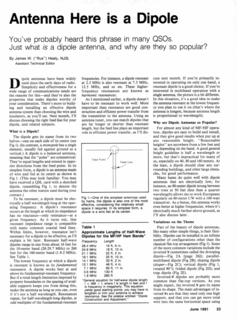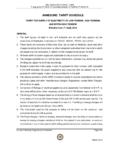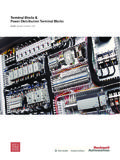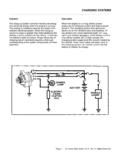Transcription of 6 SOUND MEASURING INSTRUMENTS - World Health …
1 Figure SOUND level meter block diagram6 SOUND MEASURING INSTRUMENTSP rofessor J. MalchaireUnit Hygi ne et Physiologie du TravailUniversit Catholique de Louvain (UCL)Clos Chapelle-aux-Champs 3038B-1200 INTRODUCTIONThis chapter describes the noise MEASURING INSTRUMENTS most widely used in the practice ofoccupational hygiene. The planning, the strategy and the practical aspects of a noise survey arediscussed in Chapter types of MEASURING systems can be used for the measurement of SOUND depending onthe purpose of the study, the characteristics of SOUND and the extent of information that is desiredabout the SOUND . The various elements in a MEASURING system are:a. the transducer; that is, the microphone;b. the electronic amplifier and calibrated attenuator for gain control;c. the frequency weighting or analyzing possibilities;d.
2 The data storage facilities;e. the all elements are used in every MEASURING system. The microphone can, for instance, beconnected to a SOUND level meter or directly to a magnetic tape recorder for data storage andfuture measurement or reference. An example of the components of the SOUND level meter isshown in Figure two main characteristics are:1. The frequency response: that is, the deviation between the measured value and the true value as a function of the frequency. As the ear is capable of hearing sounds between 20 Hz andSound MEASURING instruments12620 kHz, the frequency response of the SOUND level meter should be good, with variations smallerthan 1 dB, over that The dynamic range: that is, the range in dB over which the measured value is proportionalto the true value, at a given frequency (usually 1000 Hz).
3 This range is limited at low levels bythe electrical background noise of the instrument and at high levels by the signal distortion causedby overloading the microphone or The Different TypesThe microphone is the interface between the acoustic field and the MEASURING system. It respondsto SOUND pressure and transforms it into an electric signal which can be interpreted by themeasuring instrument ( the SOUND level meter). The best instrument cannot give a result betterthan the output from the microphone. Therefore, its selection and use must be carefully carriedout to avoid errors. When selecting a microphone, its characteristics must be known so that itstechnical performance ( frequency response, dynamic range, directivity, stability), in termsof accuracy and precision, meets the requirements of the measurement in question, taking intoaccount the expected conditions of use ( ambient temperature, humidity, wind, pollution).
4 The microphone can be of the following types: piezoelectric, condenser, electret or a piezoelectric microphone, the membrane is attached to a piezoelectric crystal whichgenerates an electric current when submitted to mechanical tension . The vibrations in the air,resulting from the SOUND waves, are picked up by the microphone membrane and the resultingpressure on the piezoelectric crystal transforms the vibration into an electric signal. Thesemicrophones are stable, mechanically robust and not appreciably influenced by ambient climaticconditions. They are often used in SOUND survey a condenser microphone, the microphone membrane is built parallel to a fixed plate andforms with it a condenser. A potential differential is applied between the two plates using a supply (the polarisation voltage ).
5 The movements, which the SOUND waves provoke inthe membrane, give origin to variations in the electrical capacitance and therefore in a smallelectric current. These microphones are more accurate than the other types and are mostly usedin precision SOUND level meters. However, they are more prone to being affected by dirt variation on the condenser microphone which is currently very popular is the electret. Inthis case the potential difference is provided by a permanent electrostatic charge on the condenserplates and no external polarising voltage . This type of microphone is less sensitive to dirt andmoisture than the condenser microphone with a polarisation last type is a microphone where the membrane is connected to a coil, centred in amagnetic field, and whose movements, triggered by the mechanical fluctuations of the membrane,give origin to a potential differential in the poles of the coil.
6 The dynamic microphone is moremechanically resistant but its poor frequency response severely limits its use in the field The Sensitivity of a MicrophoneThe sensitivity of a microphone is defined as the amplitude (in mV) of the output signal for anSound MEASURING instruments127 Sensitivity 20 log10Vp0V0pdB re 1V/Paincident SOUND pressure of amplitude 1 Pa (94 dB) at 1000 Hz. It can also be expressed indecibels by the following expression:Thus, a microphone giving an output signal V of 10 mV for a pressure signal p of 94 dB has asensitivity of 10 mV/Pa or -40 dB. Here p0 = 1Pa and V0 = 1 Frequency ResponseGood quality piezoelectric or condenser microphones have usually flat frequency responsecharacteristics from 2 Hz to an upper limit which depends on their size.
7 This limit is about 2 kHzfor a 1" diameter microphone, 4 kHz for a 1/2" and 8 kHz for a 1/4" microphone. Below thislimit, the frequency response is independent of the orientation of the microphone with respect tothe noise source, and therefore the microphone can be held in any orientation. Above this limit,the frequency response will depend upon the direction of the SOUND wave on the microphones have been designed in order for the response characteristics to be flatwhen the SOUND direction of propagation is perpendicular to the membrane. These microphonesare called free field microphones and should be oriented toward the most significant soundsource. Figure illustrates the frequency response characteristics of this type of Frequency response of a free field (0 ) microphoneSound MEASURING instruments128 The numbers on the curves represent the angle of incidence (in degrees) of the incoming soundwave with respect to the normal to the membrane.
8 The quantity, R , represents the response toa diffuse SOUND field ( SOUND incident equally from all possible directions).Other microphones have been designed for the response characteristics to be flat when thesound comes in all directions at the same time as in a diffuse field. They are called diffuse fieldmicrophones. Their frequency response characteristic is very near the response characteristicunder an incidence of 70 and these microphones should therefore be oriented at 70 toward thepredominant SOUND source. Figure illustrates the frequency response characteristics of this type of Frequency response of a diffuse field (R) Dynamic RangeThe output of a microphone is limited on the one hand by the internal noise of the transducer andon the other hand by the distortion resulting from high noise levels.
9 In addition, the instrumentto which the output signal of the microphone is fed will saturate if the signal is too high and willalso give a false result (that is, its background noise level) if the signal is too low. Therefore, high sensitivity microphones are needed to measure very low noise levels (lower than 30 dB), andlow sensitivity ones have to be used for high noise levels such as for impact noise (above 130 SOUND MEASURING instruments129dB). The dynamic range of typical good quality microphones is thus between 100 and 120 Selection and Use of a MicrophoneThe selection of the microphone is based on: the levels to be measured, the frequencies to be measured - low or high , the type of acoustic field - free or diffuse, the purpose and the type of measurement - overall level or frequency stated previously, the measurement of low noise levels requires high sensitivity microphonesand for high levels, low sensitivity ones are needed.
10 The problem arises outside the range 50 to120 dB usually: the characteristics indicated by the manufacturer for both the microphone andthe indicating instrument should be the noise is predominantly at frequencies below 1 kHz and overall levels are to bedetermined, any type of microphone may be used. On the contrary, if the noise is suspected orknown to include a high frequency content, or that a frequency analysis is going to be made, thefrequency characteristics of the microphone must be checked. As stated earlier, the smaller thephysical dimensions of the microphone, the wider the frequency range and the lesser the effectsof directivity since they occur at higher frequencies. Microphones of small diameter would thenbe preferable. However, they are more fragile and, with the exception of certain special ones, user must then choose between free field or diffuse field microphones.


















